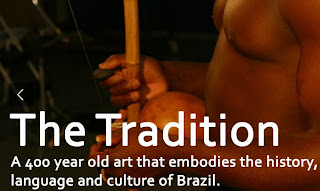(All pictures have been taken from the Salt Lake Capoeira website.)
Salt Lake Capoeira Batizado and Performance
Saturday July 9th 2011
3pm
$10 entrance fee
Utah Cultural Celebration Center
1355 W 3100 S
West Valley City, UT 84119
WHAT is a Batizado?
Every year our group holds a batizado, a celebration for our students in their accomplishments and progress. At that time, students receive their first cord (usually known as “belt” in other martial arts) and are initiated into the group.
| Batizado |
Other students change their cord for a higher level. During the week of the batizado, the students have workshops and tests which determine the cord level they will earn. The week ends with the culmination of the batizado itself.
Several guest mestres from around the United States and world come to Salt Lake to give workshops and contribute to the positive energy of the batizado. Our event usually begins with a short show, followed by the “batizado” process. The word itself means “baptism” in Portuguese; each student receiving his or her first cord plays the mestre or another teacher in the roda (circle) where the teacher “takes them down”. Each student proceeds to play a teacher and then receives his or her cord. There are several traditions involved with this event and with these, we strive to make it a memorable experience for all involved.
WHAT is Capoeira? (info from Salt Lake Capoeira website)
Capoeira is a unique Brazilian art form that combines martial arts, acrobatics, and dance-like movement performed to the beat of traditional Brazilian instruments. Though historians agree that Capoeira was devel o ped in Brazil and demonstrates a clear African influence, details on the history of Capoeira are still debated within the Capoeira community.

Even the definition of the word “Capoeira” itself remains uncertain. The most widely agreed upon explanation of the art suggests that it was developed between the sixteenth and nineteenth centuries by African slaves imported to Brazil during the slave trade. Prohibited from openly practicing forms of self-defense, slaves living on Brazilian plantations disguised their training by incorporating elements of dance, acrobatics, ritual, and music to their practice.Even
The result was a “game” of movement featuring fluid ground movement, martial sequences, and challenging acrobatics performed to the energetic singing and clapping of spectators. The practice of martial arts was not the only activity prohibited by slave owners. Traditional dances, singing, and other activities that could unite the slaves were also outlawed. Some historians believe this to be one of the reasons that Capoeira evolved the way that it did, an everchanging art that could neither be defined nor successfully banned.
Capoeira has since evolved to include all categories of movement, from traditional movement reflected in schools of Capoeira Angola, to aerial acrobatics and fast spinning kicks characteristic of contemporary Capoeira, commonly referred to as Capoeira Regional. Mestre Bimba is universally recognized as the father of Capoeira Regional, and Mestre Pastinha is the figurehead of Capoeira Angola. Legalized in Brazil in only 1953, Capoeira has experienced substantial growth within Brazil and has since weaved itself into Brazil’s cultural fabric. Today, Capoeira has become an internationally recognized art form that offers its practitioners an unforgettable experience in movement, music, and Brazilian culture.
Text taken from www.virtualcapoeira.com
Classes
- You can view the class schedule on the Salt Lake Capoeira website. It is open to many different age groups and levels. Capoeira is a great way to lose weight and get the exercise you need!
- Classes are also offered at Salt Lake Community College Redwood Campus for college credits!
More information:
- Salt Lake Capoeira is located in the Utah Arts Alliance Center in Salt Lake City.
- Salt Lake Capoeira website
- Samba Fogo, a musical group that Salt Lake Capoeira frequently performs with.
- More details about the Batizado schedule


No comments:
Post a Comment
Thank you for your comments!